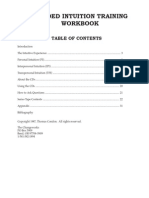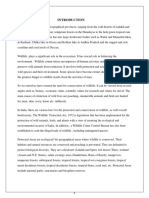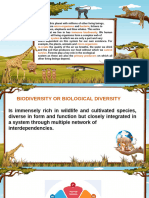Unit 2 Natural Resources and Wealth: Environmental Science Fy Bba Sem - 1
Unit 2 Natural Resources and Wealth: Environmental Science Fy Bba Sem - 1
Uploaded by
Pruthviraj RathoreCopyright:
Available Formats
Unit 2 Natural Resources and Wealth: Environmental Science Fy Bba Sem - 1
Unit 2 Natural Resources and Wealth: Environmental Science Fy Bba Sem - 1
Uploaded by
Pruthviraj RathoreOriginal Description:
Original Title
Copyright
Available Formats
Share this document
Did you find this document useful?
Is this content inappropriate?
Copyright:
Available Formats
Unit 2 Natural Resources and Wealth: Environmental Science Fy Bba Sem - 1
Unit 2 Natural Resources and Wealth: Environmental Science Fy Bba Sem - 1
Uploaded by
Pruthviraj RathoreCopyright:
Available Formats
Environmental Science
FY BBA SEM - 1
Unit 2
Natural Resources and Wealth
INTRODUCTION :
Natural resources which satisfy the material and spiritual needs of
humans are the free gifts of the nature. In other words, any
material which is valuable and useful for humans is called a
resource. These resources include physical like land, water, soils
and minerals; biological living like vegetation, wildlife and
fisheries. In fact every material has some utility for human beings
but its utilisation is possible on the availability of appropriate
technology.
MEANING :
The term resource generally means the things of utility for the
humans. It could be both natural as well as cultural. Humans
develop technologies to utilise nature favorably. The popular use
of a technology in a natural system turns it into a culture i.e. a
way of life or living. As such it attains the status of cultural
resource.
Resources form the backbone of the economy of a nation. Without
land, water, forest, air, mineral one cannot develop agriculture
and industry.
They constitute natural environment like air, water, forests and
various life forms, which are essential for human survival and
development. By utilizing natural resources, humans created their
own world of houses, buildings, means of transport and
communication, industries etc. These are also very useful along
with natural resources and these human made resources are
essential for development.
Environmental Science
FY BBA SEM - 1
Natural resources are generally defined as all those things given
by nature on, above and under the surface of the earth. In this
broad sense natural resources include land, water, forests,
fisheries and animals, mineral ores and sources of energy like
coal, petroleum, gas and uranium, etc.
TYPES
OF RESOURCES :
The type of resources available, their quantities, their distribution
within the different regions of a country determine, to a
considerable extent, the type and scale of industries that can be
developed.
In the Third World countries where level of development is still
very low, natural resources are of considerable importance. Most
of these countries lack capital, technical know-how and
enterprise, and therefore only limited substitution of capital and
labour for land and natural resources is possible, liven now, in
most of these countries the economic life is largely determined by
available resources. India is rich in natural resources.
(A)Biotic Resources:- These resources include all living
elements of the environment. Forests and forest products, crops,
birds, wildlife, fishes and other marine lives are the examples of
biotic resources. These resources reproduce and regenerate
themselves, hence, are renewable. Coal and mineral oil are also
biotic resources but they are non-renewable.
DISTRIBUTION OF BIOTIC RESOURCES
Forests : When we use the term distribution in the discipline of
geography our main concern remain with geographical or spatial
distribution of geographical phenomena. Otherwise, distribution
for a sociologist primarily mean distribution among different social
classes in a society.
Environmental Science
FY BBA SEM - 1
From a geographers point of view understanding of areas
differentiations in distribution of geographical phenomena such as
forests in the present case and to
examine the factors responsible for such differentials is first and
most vital task of
any geographical study of earths phenomena. In India, at present
forest areas cover about 76.5 million hectares of land, which is
about 23 per cent of the total geographical area. It ranges from
about 87 per cent in Andaman & Nicobar Islands to only about 4
percent in Haryana making to range difference of 83 percent.
According to our National Forest Policy, 33% of the total
geographical area of the country should be under the forest cover
to maintain ecological balance. Unfortunately, it is below the
norm outlined in our forest policy.
The vegetation found in India can be divided into six main types.
They are tropical evergreen forests, tropical deciduous forests,
thorn forests, tidal forests and mountain forests.
Wildlife : India possesses a great variety of wildlife. Out of a
known world total of 1.05 million species of animals about 75,000
species (7.46%) are found in India. India has over 1200 species of
birds.
Among the mammals we have the majestic elephant found in the
forest of Assam, Kerala and Karnataka. Camel and Wild ass are
confined to the arid areas and Runn of Kachchh in Gujarat,
respectively. Indian lions are found in the Gir forests of Gujarat.
One horned rhinos are found in the swampy and marshy lands of
Assam and West Bengal. Among the most handsome animals
include four horned antelope (Chousingha), Indian antelope (Black
buck) and gazelle. India has several species of monkeys and
deers. The species of deer include Hangul (Kashmir stag) swamp
deer, spotted deer, musk deer and mouse deer. The animals
Environmental Science
FY BBA SEM - 1
belonging to the cat family are leopards, clouded leopards and
snow leopards. Several interesting animals are found in the
Himalayan ranges such as wild sheep, mountain goats, ibex,
Shrew and tapir. Bird life is equally rich and colourful in our
country. The gorgeous peacock is Indias National Bird. In the
forests and wetlands pheasants, geese, ducks, mynahs,
parakeets, pigeons, cranes, hornbills and sunbirds are found.
There are song birds like the nightangale and the bulbul.
Livestocks : India has about three fifths or 57 per cent of the
worlds buffalo population and about one-sixth or 15 per cent of
the cattle population. Madhya Pradesh, Uttar Pradesh,
Chhattisgarh, Bihar, Uttarakhand, Jharkhand, Maharashtra, Orissa,
Karnataka and Rajasthan have over two-thirds of the cattle
population of India.
One-fourth of the total sheep of India is found in Rajasthan and
more than half of
Indias goats are found in Bihar, Jharkhand, Rajasthan, West
Bengal and Uttar
Pradesh. Farm animals such as ox, buffalos, cows are the friends
of the farming community in India. They are used in various farm
operations such as ploughing, sowing, thrashing and transporting
of farm products. However, with farm Mechanization especially in
Green Revolution areas of north western India, coastal Andhra and
Tamil Nadu and other pockets, the importance of dwarf energy for
agricultural operations is on decline. Milk is provided by the cows
and she-buffalos. Sheep provide us wool, mutton and skin. Goat
supplies milk, meat, hair, hides and skin. Chickens, ducks, geese
and turkeys are reared for eggs and feathers.
Fisheries : There is a large scope for the development of
fisheries in the country because of large continental shelf of 20
lakh square km, availability of sufficient fish food in big lakes and
Environmental Science
FY BBA SEM - 1
rivers, oceanic currents and skilled fishermen. Marine fishing is
done in seas and oceans and Inland fishing is carried out in lakes,
rivers and reservoirs.
More than 1,800 distinct species of fish are known to exist in
India. Four forms of
fisheries are found in India such as marine fisheries, freshwater or
inland fisheries,
estuarine fisheries and the peral fisheries. Marine fisheries
accounts for about 63
per cent of the annual fish production. Major fishes are sardines,
mackeral, prawns, clupeoids and silver bellies.
About two fifths or 37 per cent of the countrys total fish
production comes from
inland fisheries. Major fishes are catla, rohita, kalabasil, mringal
and carp etc. More than nine-tenths or 97 percent of the countrys
total production of marine fish and more than three-fours or 77
per cent of inland water fish is raised in Kerala, Maharasthra,
Tamil Nadu, West Bengal, Andhra Pradesh, Karnataka and Gujarat.
Notably, all are coastal states.
(B) Abiotic resources:- These resources include all non-living
elements of the environment. Land, water, air and minerals e.g.,
iron, copper, gold, silver etc. are abiotic resources. They are
exhaustible and non-renewable as they cannot be regenerated or
reproduced.
Land resources: India covers an area of 32,87,263 sq km.
According to area size, it is the seventh largest country of the
world after Russia, Canada, China, U.S.A., Brazil and Egypt. This
vast size itself is the most important resource. About 30 per cent
of area is covered by the mountains which are source of scenic
beauty, perennial rivers, home of forests and wildlife. About 43
Environmental Science
FY BBA SEM - 1
per cent of land area is plain which is highly suitable for
agriculture. Remaining about 27 percent under plateaus is the
store house of minerals and metals.
Water resources: India is fortunate to have large water
resources. Diversity in resources is the result of diversity in land
forms in the form of glaciers, surface rivers and underground
water, rains and oceans. The average annual rainfall is estimated
at 117 cm. Rivers are major source of surface water in India. The
Indus the Ganga, the Brahamputra carry about 60 per cent of the
total surface water. Replenishable groundwater potential in India
is about 434 billion cubic metres. Today, over 70 per cent of the
population uses ground water for its domestic needs and more
than half of irrigation is obtained from this source.
Mineral resources: India is very rich in mineral resources and
has the potential to become an industrial power. It possesses
large reserves of iron ore, extensive deposits of coal, mineral oil,
rich deposits of bauxite and mica. Jharkhand, Orissa and
Chhattisgarh possess large concentration of mineral deposits,
accounting for nearly threefourths of the countrys coal deposits.
Other important minerals found in our country are iron ore,
manganese, mica, bauxite and radioactive minerals.
Resource Utilision:
To satisfy their needs, Humans have been using resources for time
immerged. This process is called resource utilisation. Human
skills, technical know how and
hard work converts the neutral stuff into a commodity or service
to serve material
and spiritual needs of the human society. Thus resources are
created by man.
In the modern age, the application of science and technology has
increased the human capacity and capability to use resources in
efficient manner for production
Environmental Science
FY BBA SEM - 1
purposes. For example, United States of America and West
European countries have high developed economies for efficient
use of their natural wealth with advanced technologies.
On the other hand, several countries in Africa, Asia and Latin
America are lagging far behind in development level inspite of
abundant natural resources there. Since, these countries are
lagging behind in terms of advanced technology.
The natural resources have played a significant role in the socioeconomic development of our country. India is the second largest
agricultural giant in the world today. It is because India has varied
climatic conditions and an endless growing seasons to grow
different crops. Indias large mineral wealth has enabled India to
be industrially developed.
In recent decades, in our desire not only to feed the fastly growing
population but
also to accelerate economic well being to vast Indian population,
exploitation of resources has increased phenomenally. This has
led to environmental and ecological imbalances as resources were
used on un-sustainable basis. Production of resources has been
motivated by the maximization of output and profit maximization
rather than the optimixation of net social benefits.RESOURC
Under pressure from rapid population growth the available
resources of water are being exploited and depleted at a fast rate.
Due to lack of technology only 37 per cent of total annual flow of
Indian rivers and equal proportion of the available ground water
resource is available for use.
After independence, the fisheries Industry, particularly the marine
sector, has witnessed a massive transformation from a traditional
and subsistence type enterprise to market driven multi corer
Environmental Science
FY BBA SEM - 1
industry. Currently, India exports nearly 55 categories of marine
products to South Asian, European countries and U.S.A.ES
You might also like
- Ibrahim Dincer - Thermodynamics - A Smart ApproachDocument673 pagesIbrahim Dincer - Thermodynamics - A Smart Approachmdtarequl.islam100% (12)
- CASE 580 Super M+ Series 2 Backhoe Loader Parts Catalogue Manual PDFDocument57 pagesCASE 580 Super M+ Series 2 Backhoe Loader Parts Catalogue Manual PDFfjjsekfksemm18% (11)
- Osmosis Worksheet (30 PTS)Document2 pagesOsmosis Worksheet (30 PTS)RhynnieNo ratings yet
- LF90LS Operations and Service Manual PDFDocument154 pagesLF90LS Operations and Service Manual PDFDavid Fino Y. Seguro100% (2)
- India As A Mega Diversity NationDocument14 pagesIndia As A Mega Diversity NationAshi Gupta72% (18)
- Expanded Intuition Workbook - PDF FormatDocument36 pagesExpanded Intuition Workbook - PDF FormatAquiles Lo50% (2)
- General Rules and Guidelines For IMDS Material DatasheetsDocument22 pagesGeneral Rules and Guidelines For IMDS Material DatasheetsVanessa Alves MoreiraNo ratings yet
- Jess 102 NCERT X SSDocument9 pagesJess 102 NCERT X SSKumara55No ratings yet
- Biodiversity of India - Flora Form - Dr. JasraiDocument12 pagesBiodiversity of India - Flora Form - Dr. JasraiBotsivaNo ratings yet
- Biodiversity Hot SpotsDocument4 pagesBiodiversity Hot SpotsSomya SomuNo ratings yet
- FOREST & WILDLIFE RESOURCES_041247Document23 pagesFOREST & WILDLIFE RESOURCES_041247rubyo2833No ratings yet
- UntitledDocument20 pagesUntitledEmilda SaraNo ratings yet
- Environmental Science I Sem-1Document29 pagesEnvironmental Science I Sem-1leomaximum10No ratings yet
- Biodiversity 1Document14 pagesBiodiversity 1Prabhat Kusum PandaNo ratings yet
- Forest and Wildlife - Shobhit NirwanDocument5 pagesForest and Wildlife - Shobhit NirwanTarun Jain92% (12)
- Bio Diversity and Its Conservation (Module 2)Document39 pagesBio Diversity and Its Conservation (Module 2)devikaspanicker1No ratings yet
- Vansh Environmental LawDocument35 pagesVansh Environmental LawVanshdeep Singh SamraNo ratings yet
- Wildlife Conservation in India (Geography Record)Document9 pagesWildlife Conservation in India (Geography Record)Kripesh KumarNo ratings yet
- Chapter 2 Forest and Wildlife ResourcesDocument6 pagesChapter 2 Forest and Wildlife Resourcespandeneeta100% (1)
- Wildlife ConservationDocument14 pagesWildlife ConservationRutik PanchalNo ratings yet
- Harsh2Document8 pagesHarsh2rajesh1995santNo ratings yet
- Geo CHP 2 Notes PsDocument7 pagesGeo CHP 2 Notes PssamihanchatterjeeNo ratings yet
- Biology ProjectDocument9 pagesBiology ProjectSk Akif AhmadNo ratings yet
- Values Threats of Biodiversity and Wildlife ProjectsDocument17 pagesValues Threats of Biodiversity and Wildlife Projectskoreandrama4748No ratings yet
- ENVS ProjectDocument17 pagesENVS Projecttiwarianant247No ratings yet
- ENVS Project....Document19 pagesENVS Project....tiwarianant247No ratings yet
- India As A Mega Diversity NationDocument7 pagesIndia As A Mega Diversity NationAayat FaridNo ratings yet
- Biodiversity Hotspots in India UPSC Notes GS IIIDocument5 pagesBiodiversity Hotspots in India UPSC Notes GS IIIabhinavtaryalNo ratings yet
- SST PPT Forest and Wildlife ResourcesDocument23 pagesSST PPT Forest and Wildlife ResourcesShubham75% (8)
- Name: Rohit Ratan UNIVERSITY ROLL NO: 201434-21-0112 College Name: Shree Agrasain College Topic: A Study On Local Biodiversity: FloraDocument21 pagesName: Rohit Ratan UNIVERSITY ROLL NO: 201434-21-0112 College Name: Shree Agrasain College Topic: A Study On Local Biodiversity: FloraVishal DubeyNo ratings yet
- Conservation of Forest Biodiversity in India: K. VenkataramanDocument8 pagesConservation of Forest Biodiversity in India: K. VenkataramanAshutosh ManiNo ratings yet
- BiodiversityDocument15 pagesBiodiversityChIrag JainNo ratings yet
- Wildlife Conservation Efforts inDocument30 pagesWildlife Conservation Efforts inparamjain100% (6)
- Bandipur National ParkDocument6 pagesBandipur National ParkNasreen FatimaNo ratings yet
- Geography - Forest and Wildlife Resources - Revision Notes - (Udaan 2024)Document32 pagesGeography - Forest and Wildlife Resources - Revision Notes - (Udaan 2024)Divyam GargNo ratings yet
- Forest and Wildlife Resources - Short NotesDocument3 pagesForest and Wildlife Resources - Short Notesidhika8098No ratings yet
- A Study On Local BiodiversityDocument18 pagesA Study On Local Biodiversitysagaransari558No ratings yet
- 4 Biodiversity IiDocument21 pages4 Biodiversity IiaditikaushikNo ratings yet
- Flora and Fauna of Odisha: Presented By: Agrodwip Das Class: 9 D Roll No.:18Document10 pagesFlora and Fauna of Odisha: Presented By: Agrodwip Das Class: 9 D Roll No.:18Papiya DasNo ratings yet
- Forest and Wildlife Yt - PPTX 20240808 222035 0000Document23 pagesForest and Wildlife Yt - PPTX 20240808 222035 0000Proneeta SinghNo ratings yet
- India As A Mega-Diversity NationDocument10 pagesIndia As A Mega-Diversity NationVansh R.No ratings yet
- Wildlife Protection ActDocument4 pagesWildlife Protection Actrajeshsisondiya7No ratings yet
- ENVS Project 1Document17 pagesENVS Project 1tiwarianant247No ratings yet
- RBSE Class 8 Science Notes Chapter 5 Biodiversity - RBSE GuideDocument3 pagesRBSE Class 8 Science Notes Chapter 5 Biodiversity - RBSE GuideAlpine AcademiaNo ratings yet
- Chapter 05 Natural Vegetation and Wildlife 1715920793Document31 pagesChapter 05 Natural Vegetation and Wildlife 1715920793Brijnandan KumarNo ratings yet
- 01-Main Intro-1-56 PDFDocument56 pages01-Main Intro-1-56 PDFPratyush OnkarNo ratings yet
- Biodiversity Hotspots in IndiaDocument15 pagesBiodiversity Hotspots in Indiabeniwalkhushi27No ratings yet
- Biodiversity Profile of India: March 2017Document12 pagesBiodiversity Profile of India: March 2017sem31No ratings yet
- Forestsandwildliferesources 170314081447Document22 pagesForestsandwildliferesources 170314081447Priya Ranjan JenaNo ratings yet
- Forest and Wildlife Resources Notes by AmithDocument8 pagesForest and Wildlife Resources Notes by AmithAMITH NAIRNo ratings yet
- WildDocument3 pagesWildalbinkunnappallilNo ratings yet
- Practical 1Document11 pagesPractical 1Ankit KumarNo ratings yet
- biodiversity-1Document15 pagesbiodiversity-1Laarkisha Angelina Ngoruw MoyonNo ratings yet
- NCERT Summary Forest - Wildlife ResourcesDocument5 pagesNCERT Summary Forest - Wildlife ResourcesSahilNo ratings yet
- Forest & Wildlife ResourcesDocument5 pagesForest & Wildlife Resourcesharsh43yadav42No ratings yet
- STD XGeo Le-2 ModifiedDocument5 pagesSTD XGeo Le-2 ModifiedAmmu KarthiNo ratings yet
- 10th Geo CHP 2 - NotesDocument4 pages10th Geo CHP 2 - Notesspecialiam541No ratings yet
- Wildlife Conservation Efforts in IndiaDocument12 pagesWildlife Conservation Efforts in IndiaSushant Dwivedy69% (35)
- Session 1Document5 pagesSession 1Pruthviraj RathoreNo ratings yet
- Module - 4Document41 pagesModule - 4Pruthviraj RathoreNo ratings yet
- Module-2 Consumer Behavior: Nptel Vinod Gupta School of Management Consumer BehaviorDocument17 pagesModule-2 Consumer Behavior: Nptel Vinod Gupta School of Management Consumer BehaviorPruthviraj RathoreNo ratings yet
- Module - 2Document40 pagesModule - 2Pruthviraj RathoreNo ratings yet
- Jvims Mba Semester Iii Summer Internship Training (SIP) GuidelinesDocument11 pagesJvims Mba Semester Iii Summer Internship Training (SIP) GuidelinesPruthviraj RathoreNo ratings yet
- Module - 2 Consumer Behavior: Nptel Vinod Gupta School of Management Consumer BehaviorDocument24 pagesModule - 2 Consumer Behavior: Nptel Vinod Gupta School of Management Consumer BehaviorPruthviraj RathoreNo ratings yet
- CB & STPDocument20 pagesCB & STPPruthviraj RathoreNo ratings yet
- Credit Rating AgencyDocument6 pagesCredit Rating AgencyPruthviraj RathoreNo ratings yet
- SRMDocument2 pagesSRMPruthviraj RathoreNo ratings yet
- 7 Product PortfoliosDocument22 pages7 Product PortfoliosPruthviraj RathoreNo ratings yet
- 5-6 The Product Life Cycle in Theory and PracticeDocument32 pages5-6 The Product Life Cycle in Theory and PracticePruthviraj RathoreNo ratings yet
- Unit 1 HRM: Prepared By: Pruthvirajsinh N Rathod 1Document76 pagesUnit 1 HRM: Prepared By: Pruthvirajsinh N Rathod 1Pruthviraj RathoreNo ratings yet
- 1-2 Competition and Product StrategyDocument32 pages1-2 Competition and Product StrategyPruthviraj RathoreNo ratings yet
- Chapter 1 - Basic Concept of Service MarketingDocument15 pagesChapter 1 - Basic Concept of Service MarketingPruthviraj RathoreNo ratings yet
- People S Role in Service Firms The People Element in The Service Marketing Mix Refers To All of The HumanDocument22 pagesPeople S Role in Service Firms The People Element in The Service Marketing Mix Refers To All of The HumanPruthviraj RathoreNo ratings yet
- Prepared By: Pruthvirajsinh N Rathod 1Document66 pagesPrepared By: Pruthvirajsinh N Rathod 1Pruthviraj RathoreNo ratings yet
- Chintan Project MBA-4Document69 pagesChintan Project MBA-4Pruthviraj RathoreNo ratings yet
- Project Report On Mergers and AcquisitionsDocument1 pageProject Report On Mergers and AcquisitionsPruthviraj RathoreNo ratings yet
- Tools and Techniques of NPADocument9 pagesTools and Techniques of NPAPruthviraj RathoreNo ratings yet
- Brand PositioningDocument30 pagesBrand PositioningPruthviraj RathoreNo ratings yet
- Faculty Development Programme in ManagementDocument4 pagesFaculty Development Programme in ManagementPruthviraj RathoreNo ratings yet
- STRBI Table No. 12 Selected Ratios of Scheduled Commercial BanksDocument266 pagesSTRBI Table No. 12 Selected Ratios of Scheduled Commercial BanksPruthviraj RathoreNo ratings yet
- Mba Project TopicsDocument23 pagesMba Project TopicsPruthviraj RathoreNo ratings yet
- Top 10 Classroom Games - Quizalize BlogDocument20 pagesTop 10 Classroom Games - Quizalize BlogPruthviraj RathoreNo ratings yet
- Consumer BahaviourDocument14 pagesConsumer BahaviourPruthviraj RathoreNo ratings yet
- Elements of Curriculum DesignDocument6 pagesElements of Curriculum DesignMary Ann Suzette Anub100% (2)
- Aquatic Invasive Species Affirmative - Michigan7 2014 GRAMSDocument112 pagesAquatic Invasive Species Affirmative - Michigan7 2014 GRAMSZakCherifNo ratings yet
- pr2 ReviseDocument63 pagespr2 ReviseSan Agustin ESNo ratings yet
- TRAINSDocument5 pagesTRAINSTHE VISIONNo ratings yet
- Applied-Physics-1 Main NotesDocument124 pagesApplied-Physics-1 Main Notesrushikesh pandyaNo ratings yet
- Attitudes and Attitude ChangeDocument40 pagesAttitudes and Attitude ChangeDaniel Venables100% (1)
- Ác Ác Ác ÁcDocument12 pagesÁc Ác Ác ÁcMran QilaNo ratings yet
- 2_Mini_MidiDocument16 pages2_Mini_Midihamza rezguiNo ratings yet
- Arts Unit I Lesson I-2 Art AppreciationDocument2 pagesArts Unit I Lesson I-2 Art AppreciationPRINTDESK by DanNo ratings yet
- Your Airline: Normal ChecklistDocument1 pageYour Airline: Normal ChecklistМистермарк МистерклимюкNo ratings yet
- Pre-Service Teachers Reflections On Prior ExperieDocument15 pagesPre-Service Teachers Reflections On Prior ExperieJerry F. Abellera Jr.No ratings yet
- Green Marketing-Complete PaperDocument10 pagesGreen Marketing-Complete PaperTanya GrewalNo ratings yet
- Batul Zaheer PatelDocument44 pagesBatul Zaheer PatelbatulNo ratings yet
- Etext and Textbooks Etext RequirementsDocument8 pagesEtext and Textbooks Etext RequirementsChelseaNo ratings yet
- Slump Test Report PMMDocument7 pagesSlump Test Report PMMLuqman Yusof83% (12)
- Cardiac CycleDocument24 pagesCardiac CyclesureshNo ratings yet
- Solve The Below Product Mix Problem Using LINGO's Modeling LanguageDocument1 pageSolve The Below Product Mix Problem Using LINGO's Modeling LanguagevedhaNo ratings yet
- Final Project Report 1Document35 pagesFinal Project Report 1rjenterprises 2018No ratings yet
- Azizi Anas - MEC551 - Assignment - 1 CHAPTER 1 To 3 - May 2020Document2 pagesAzizi Anas - MEC551 - Assignment - 1 CHAPTER 1 To 3 - May 2020Azizi AnasNo ratings yet
- Case Management Information System - Kosovo Case StudyDocument4 pagesCase Management Information System - Kosovo Case Studynewguyat77No ratings yet
- GalhoDocument15 pagesGalhoJunior CapixabaNo ratings yet
- FMT M - Fmtx1-Xxxx: Ransmitter OdulesDocument6 pagesFMT M - Fmtx1-Xxxx: Ransmitter Odulesinsomnium86No ratings yet
- SAP Marketing With No of ClicksDocument208 pagesSAP Marketing With No of ClicksRajesh MathurNo ratings yet
- Grade 11 TM Unit 1 - Programming - FINALDocument60 pagesGrade 11 TM Unit 1 - Programming - FINALJamunanantha Pranavan100% (1)


















































































































